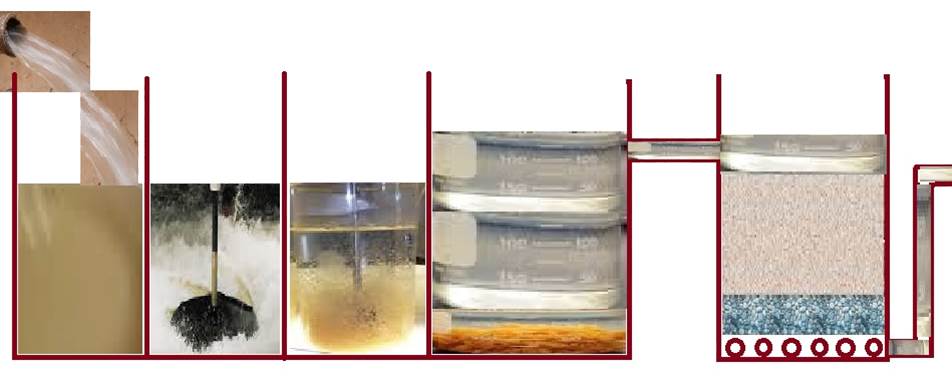
Are of two types:
1. Gravity type (Paterson’s filter)
2. Pressure type (e.g. Candy’s filter)
Steps in purification of water using rapid sand filter
1. Coagulation
2. Rapid mixing
3. Flocculation
4. Sedimentation and THEN
5. Filtration: using the rapid sand filter
1. Coagulation:
• Raw water is first treated with chemical coagulant such as alum
• The dose varies from 5 to 40 mg/L, depending upon:
– Turbidity
– Colour
– Temperature and
– pH value of raw water
2. Rapid mixing
• The treated water is then subjected to violent agitation in a ‘Mixing Chamber’ for a few minutes
• This allows a quick and thorough dissemination of alum throughout the bulk of water
• This thorough mixing is very necessary
3. Flocculation
– Slow and gentle stirring of the treated water in a ‘flocculation chamber’ for 30 minutes
– It consists of a number of paddles which rotate at 2 – 4 rpm, with the help of motors
– This slow and gentle stirring results in the formation of a thick, copious, white flocculent precipitate of aluminium hydroxide
– The thicker the precipitate diameter, the greater the settling velocity
4. Sedimentation:
– The coagulated water is now led into sedimentation tanks
– Here it is detained for periods varying from 2 – 6 hours
– The flocculent precipitate together with impurities and bacteria settle down in the tank
– At least 95% of the flocculent precipitate needs to be removed before the water is admitted into the rapid sand filters
– The sludge which settles at the bottom is removed from time to time without disturbing the operation of the tank
– The tanks should be cleaned regularly otherwise they may become a breeding ground for molluscs and sponges
5. Filtration: the partly clarified water is now subjected to rapid sand filtration
Sand is the filtering medium
– Size of the sand grains 0.4 – 0.7 mm
– Each unit of filter has a surface of about 80 – 90 sq m (900 sq feet)
– Depth of the bed is usually about 1meter
Below the sand bed is a layer of graded gravel 30 – 40 cm deep
– The gravel supports the sand bed and
– Permits the filtered water to move freely towards the under – drains
The depth of the water on the top of the sand bed is 1 – 1.5 m
The under- drains at the bottom of the filter beds collect the filtered water
• The rate of filtration is 5 – 15 L/sq. m/ hour
• As filtration proceeds, some alum floc not removed by sedimentation is held back on the sand bed
– This forms a slimy layer
– This layer adsorbs the bacteria and purifies the water
• Oxidation of ammonia occurs during the passage of water through the filters
• As filtration proceeds, the suspended impurities and bacteria clog the filters the filters soon become dirty and begin to lose their efficiency
• When the ‘loss of head’ approaches 7 – 8 feet, filtration is stopped and the filters are subjected to a washing process k/a ‘backwashing’
Backwashing:
– Required daily or weekly depending upon the ‘loss of head’
– Washing is accomplished by reversing the flow of water through the sand bed
– Backwashing dislodges the impurities and cleans up the sand bed
– The washing is stopped when clear sand is visible and the wash water is sufficiently clear
– The whole process takes about 15 minutes
– In some rapid sand filter, compressed air is used as a part of the backwashing process
Advantages of Rapid Sand Filter
– Rapid sand filter can deal with raw water directly, i.e. no preliminary storage is needed
– The filter beds occupy less space
– Filtration is rapid (40 – 50 times faster than slow sand filter)
– Washing of the filter is easier
– There is more flexibility in operation
OT and OTA test: http://www.ihatepsm.com/blog/orthotolidine-ot-test-and-orthotolidine-%E2...
Membrane processes in water purification: http://www.ihatepsm.com/blog/membrane-processes-treatment-drinking-water
Super Chlorination and Break Point Chlorination: http://www.ihatepsm.com/blog/super-chlorination-and-break-point-chlorina...
Slow sand filter: http://www.ihatepsm.com/blog/slow-sand-filter-biological-filter
Rapid sand filter: http://www.ihatepsm.com/blog/rapid-sand-filter-mechanical-filter
Purification of water at a large scale: http://www.ihatepsm.com/blog/water-purification-large-scale-water-supply
Criteria for a Chemical to be Suitable as Water Disinfectant in Water Supplies: http://www.ihatepsm.com/blog/criteria-chemical-be-suitable-water-disinfe...
Water Supplies Disinfection with Chlorination: http://www.ihatepsm.com/blog/water-supplies-disinfection-chlorination
Principles of Chlorination: http://www.ihatepsm.com/blog/principles-chlorination
Methods of Chlorination in Water Supplies: http://www.ihatepsm.com/blog/methods-chlorination-water-supplies
Horrock's Apparatus: http://www.ihatepsm.com/blog/horrock%E2%80%99s-apparatus
Disinfection of well during emergency: http://www.ihatepsm.com/blog/disinfection-wells-during-emergency-%E2%80%...
Double Pot method: http://www.ihatepsm.com/blog/disinfection-wells-during-emergency-%E2%80%...
Disinfection of Wells: http://www.ihatepsm.com/blog/disinfection-wells
OT and OTA test: http://www.ihatepsm.com/blog/ot-and-ota-test
Domestic or Household Purification of Water: http://www.ihatepsm.com/blog/domestic-or-household-purification-water
